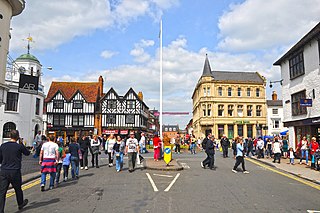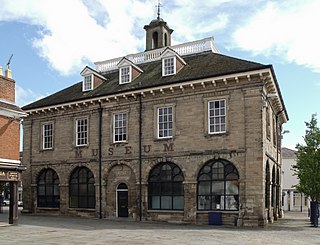
Stratford-upon-Avon, commonly known as just Stratford, is a market town and civil parish in the Stratford-on-Avon district, in the county of Warwickshire, in the West Midlands region of England. It is situated on the River Avon, 91 miles (146 km) north-west of London, 22 miles (35 km) south-east of Birmingham and 8 miles (13 km) south-west of Warwick. The town is the southernmost point of the Arden area on the edge of the Cotswolds. In the 2021 census Stratford had a population of 30,495.

St Ives is a medieval market town and civil parish in the Huntingdonshire district in Cambridgeshire, England, 5 miles (8 km) east of Huntingdon and 12 miles (19 km) north-west of Cambridge. St Ives is historically in the historic county of Huntingdonshire.

Royal Leamington Spa, commonly known as Leamington Spa or simply Leamington, is a spa town and civil parish in Warwickshire, England. Originally a small village called Leamington Priors, it grew into a spa town in the 18th century following the popularisation of its water which was reputed to have medicinal qualities. In the 19th century, the town experienced one of the most rapid expansions in England. It is named after the River Leam, which flows through the town.

Southam is a market town and civil parish in the Stratford-on-Avon district of Warwickshire, England. Southam is situated on the River Stowe, which flows from Napton-on-the-Hill and joins Warwickshire's River Itchen at Stoneythorpe, just outside the town.

Warwick is a market town, civil parish and the county town of Warwickshire in the Warwick District in England, adjacent to the River Avon. It is 9 miles (14 km) south of Coventry, and 19 miles (31 km) south-east of Birmingham. It is adjoined with Leamington Spa and Whitnash.

Bedworth is a market town and unparished area in the borough of Nuneaton and Bedworth, Warwickshire, England. It is situated between Coventry, 6 miles to the south, and Nuneaton, 3 miles (5 km) to the north.

Alcester is a market town and civil parish of Roman origin at the junction of the River Alne and River Arrow in the Stratford-on-Avon District in Warwickshire, England, approximately 8 mi (13 km) west of Stratford-upon-Avon, and 7 miles south of Redditch, close to the Worcestershire border.

Kineton is a village and civil parish on the River Dene in south-east Warwickshire, England. The village is part of Stratford-on-Avon district, and in the 2001 census it had a population of 2,278, increasing to 2,337 at the 2011 Census.

New Street is a street in central Birmingham, England. It is one of the city's principal thoroughfares and shopping streets linking Victoria Square to the Bullring Shopping Centre. It gives its name to New Street railway station, although the station has never had direct access to New Street except via the Grand Central shopping centre through Stephenson Street.

Nottingham city centre is the cultural, commercial, financial and historical heart of Nottingham, England. Nottingham's city centre represents the central area of the Greater Nottingham conurbation.
Budbrooke is a village and civil parish in the Warwick district of Warwickshire, England. It is 3 miles west of Warwick and according to the 2001 census the parish had a population of 2,319, reducing to 1,863 at the 2011 Census. Most of the population of Budbrooke live in Hampton Magna, a housing estate built in the late 1960s, with other smaller settlements in Budbrooke Village and Hampton on the Hill.

The architecture of Aylesbury, the county town of Buckinghamshire, reflects that which can be found in many small towns in England. The architecture contained in many of the country's great cities is well recorded and documented, as is that of the numerous great country houses. Frequently, the work is by one of England's more notable architects – Christopher Wren, John Vanbrugh, Robert Adam, William Kent or even Quinlan Terry. What is less well known is the local architecture in the market towns, often inspired by the work of the great master architects or architectural styles popular at the time. English merchants would often return from a visit to one of the nearby cities, or having seen a glimpse of one of the great country houses then require a replica of what they had seen. A local architect would then be employed to recreate it, within limited financial restraints. Sometimes the patron would merely draw an image of what he required and a builder would then interpret the requirements to the best of his often limited ability.


Corn Exchange Street is a street in central Cambridge, England. It runs between Wheeler Street to the northwest and Downing Street to the southeast. To the northeast, Guildhall Place, a cul-de-sac, runs parallel with Corn Exchange Street at the northern end, an extension of Guildhall Street.

Priory Park is an urban park located in the centre of Warwick, England. Originally the land was the grounds of a 12th-century priory dedicated to St Sepulchre and built in 1124 but this was closed down by King Henry VIII during the dissolution of the Monasteries. It was then destroyed and a residential home was built in 1566 by a man named Thomas Fisher known as Hawkins. In the 17th century, the estate was owned by Sir Thomas Puckering, 1st Baronet and his heirs, including Sir Henry Puckering, 3rd Baronet who was MP for Warwickshire and then the borough of Warwick.

St John's House is an historic house located in Warwick, just east of the town centre, in Warwickshire, England. It is now an Education, Event and Wedding Venue operated by Heritage and Culture Warwickshire, part of Warwickshire County Council. It has a history spanning almost 900 years. To the side of the house is a small garden belonging to St John's and to the rear is the large St. Nicholas' Park. The current grade I listed building dates from around 1666, and is considered one of the most important buildings in Warwick.

Market Hall Museum is an historic museum located in Warwick, in Warwickshire, England. The Market Hall forms part of The Warwickshire Museum. The Warwickshire Museum is operated by Heritage and Culture Warwickshire. The collections on display at Market Hall are primarily focused on objects in the fields of archaeology, geology and natural history, and particularly those local to Warwickshire.

Corn exchanges are distinct buildings which were originally created as a venue for corn merchants to meet and arrange pricing with farmers for the sale of wheat, barley, and other corn crops. The word "corn" in British English denotes all cereal grains, such as wheat and barley. With the repeal of the Corn Laws in 1846, a large number of corn exchanges were built in England, particularly in the corn-growing areas of Eastern England.

Farnham Town Hall is a municipal building in South Street, Farnham, Surrey, England. It provides the offices and the meeting place of Farnham Town Council.

The Exchange was a large and prominent Victorian commercial building in central Birmingham, England, on the corner of New Street and Stephenson Place. It was among the many Victorian buildings lost during the 1960s redevelopment of Birmingham.




















